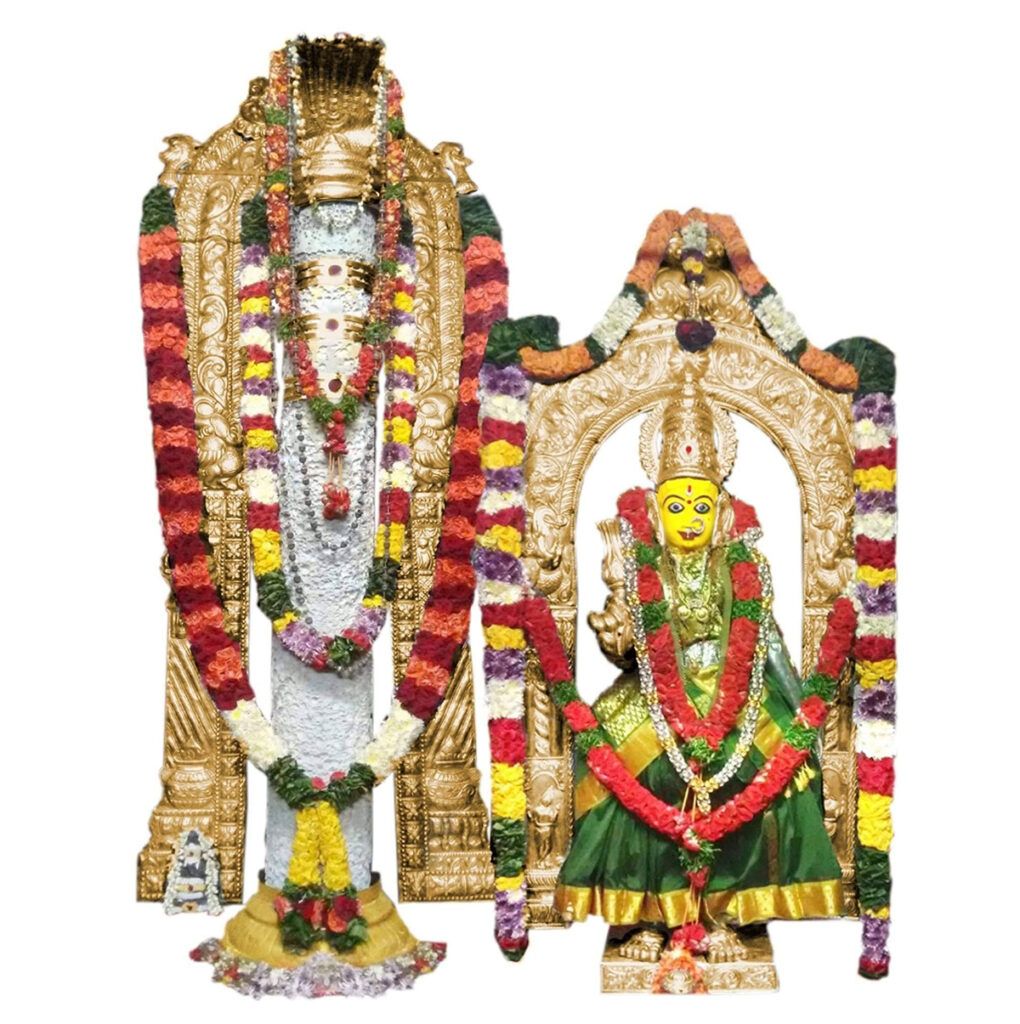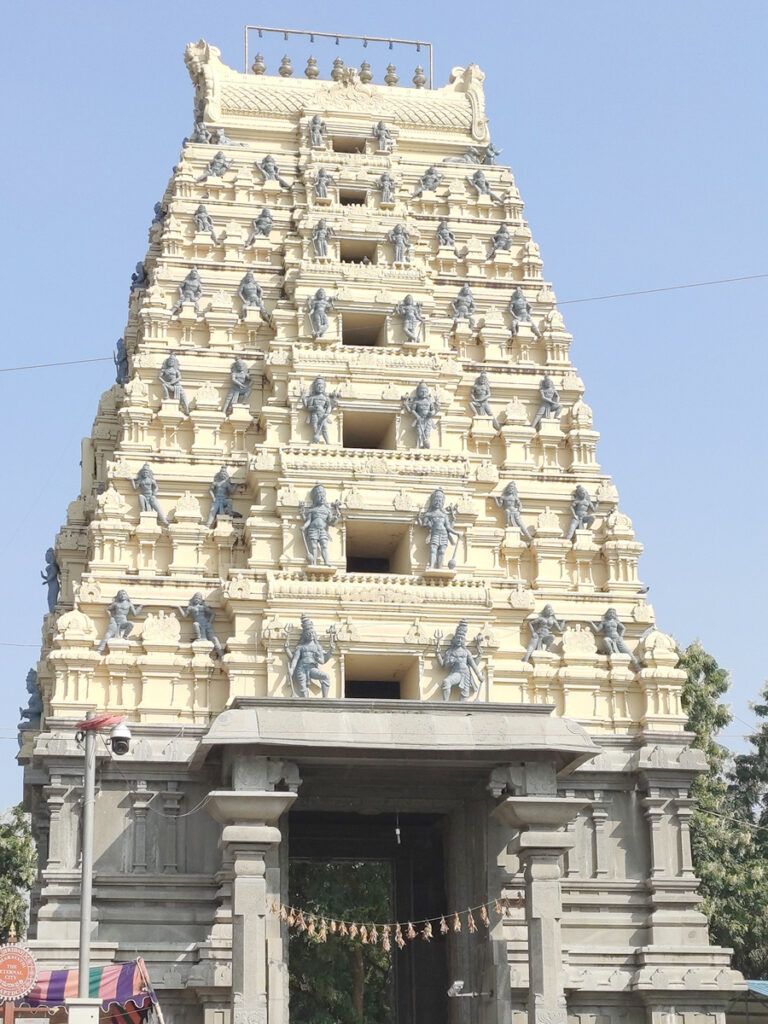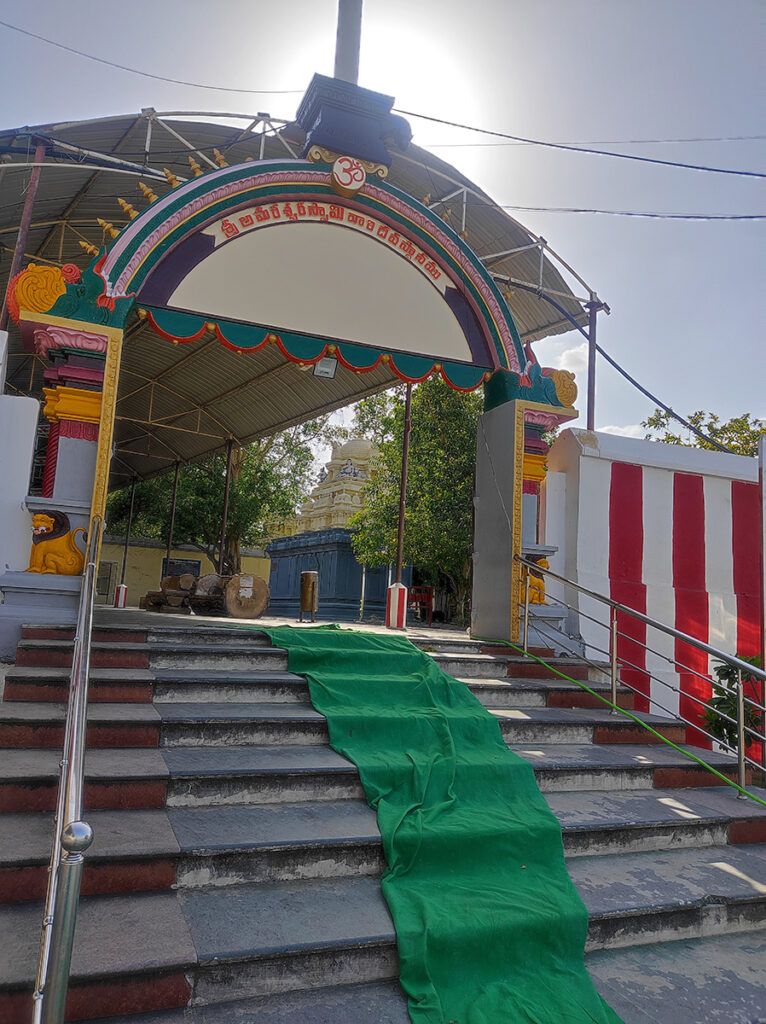Amareswara Temple (Immortal)Amaravati: Sacred 5 Shiva Lingas
The Amareswara Temple or Amaralingeswara Swamy in Amaravati, Andhra Pradesh, India is one of the five Pancharama Kshetras, which are sacred to the Hindu god Shiva. The temple is believed to have been built in the 3rd century BCE, but the current structure was built by the Vijayanagara Empire in the 16th century.

The temple is dedicated to Lord Amareswara, who is a form of Lord Shiva. The temple is situated on a hill on the southern bank of the Krishna River. The main shrine of the temple houses a 15-feet tall marble Shiva Lingam. The temple also has shrines dedicated to Goddess Bala Chamundika, the consort of Lord Amareswara, and other deities.
The Amaralingeswara Swamy Temple is a popular pilgrimage site for Hindus from all over India. The temple is especially crowded during the Karthika Masam festival, which is celebrated in the Hindu month of Kartika (October-November).
Contents
- 1 History of the Amareswara Temple
- 2 Mythology of the Amareswara Temple
- 3 Legend of Amareswara Temple Amaravati:
- 4 Places to visit near Amareswara Temple Amaravati:
- 5 FAQ:
- 5.0.1 Q: What is the Amareswara Temple?
- 5.0.2 Q: When was the Amareswara Temple built?
- 5.0.3 Q: What is the significance of the Amareswara Temple?
- 5.0.4 Q: What are the main attractions of the Amareswara Temple?
- 5.0.5 Q: What are the timings of the Amareswara Temple?
- 5.0.6 Q: What is the best time to visit the Amareswara Temple?
- 5.0.7 Q: What are the dress code and other restrictions for visiting the Amareswara Temple?
- 5.0.8 Q: How to get to the Amareswara Temple?
- 5.0.9 Q: Where to stay near the Amareswara Temple?
- 5.0.10 Q: What are other places to visit near the Amareswara Temple?
- 6 How to reach Amareswara Temple Amaravati:
- 7 Google Maps:
History of the Amareswara Temple
The Amareswara Temple is believed to have been built in the 3rd century BCE by the Satavahana dynasty. The temple was a major center of Hinduism during the Satavahana period. The temple was also a major center of Buddhist art and architecture during this period.
The Amaralingeswara Swamy Temple was destroyed by the Muslim invaders in the 13th century. The temple was rebuilt by the Vijayanagara Empire in the 16th century. The Vijayanagara Empire also added many new features to the temple, such as the gopurams (gateway towers) and the mandapa (hall).
The Amareswara Temple was again damaged by the Muslim invaders in the 17th century. The temple was renovated by the zamindars of Amaravati in the 18th century.
Read More>> Swaminatha Swamy Temple Swamimalai

Mythology of the Amareswara Temple
According to Hindu mythology, the Amareswara Temple is one of the five Pancharama Kshetras, which are sacred to the Hindu god Shiva. The Pancharama Kshetras are believed to have been created when the Shivalingam in the throat of Lord Subramanya broke into five pieces and fell to the earth. The five pieces of the Shivalingam are said to have fallen at the following places:
- Amareswara Temple, Amaravati
- Someswara Temple, Bhimavaram
- Kedareswara Temple, Srikakulam
- Draksharama Temple, Draksharama
- Ksheeraramam Temple, Palakollu
The Amareswara Temple is also associated with the Hindu god Vishnu. According to mythology, Lord Vishnu is said to have worshipped Lord Shiva at the Amareswara Temple.
Read More>> Subramanya Swamy Temple at Thiruchendur A Sacred Gem
Legend of Amareswara Temple Amaravati:
The legend of the Amareswara Temple is associated with the demon king Tarakasura, who attained a boon from Lord Shiva that he could only be killed by the son of Shiva and Parvati. Tarakasura became very powerful and defeated the Devas, the gods and goddesses of Hinduism. The Devas came to Amaravati and prayed to Lord Shiva to help them defeat Tarakasura.
Lord Shiva and Parvati had a son named Kartikeya, who was also known as Subramanya. Kartikeya defeated Tarakasura in a fierce battle. When Tarakasura was killed, the Shivalinga in his throat broke and fell in five different places, which became the Pancharama Kshetras.
The Amareswara Temple is believed to be the place where the Shivalinga fell from Tarakasura’s throat. The Sivalinga in the temple is said to have been installed by Lord Indra himself.
Another legend associated with the Amaralingeswara Swamy Temple is that of Vasireddy Venkatadri Naidu, a king of Chintapalli and Dharanikota. Vasireddy Venkatadri Naidu was a great devotee of Lord Shiva. Once, the king had to put down a rebellion in his land. In the course of the rebellion, the king had to order the massacre of the Chenchus, a tribal community. The king was deeply disturbed by the massacre and lost his mental peace.
Vasireddy Venkatadri Naidu came to Amaravati and prayed to Lord Amareswara Swamy for forgiveness. The king regained his mental peace and decided to devote his life to the service of Lord Shiva. He renovated and expanded the Amaralingeswara Swamy Temple.
Read More>> Enchanting Beauty of Madurai Meenakshi Amman Temple

Places to visit near Amareswara Temple Amaravati:
Amaravati Stupa: The Amaravati Stupa, also known as the Mahachaitya, is an ancient Buddhist stupa that dates back to the 3rd century BCE. It’s located near the Amareswara Temple and is a significant historical site.
Dhyana Buddha Statue: Located near the Amaravati Stupa, this towering Dhyana Buddha statue is one of the tallest monolithic Buddha statues in India. It’s a serene and contemplative place to visit.
Nagarjunakonda: This island on the Nagarjuna Sagar Reservoir is home to archaeological remains, including Buddhist stupas, monasteries, and sculptures. It’s an important historical and cultural site, and you can take a boat ride to explore the island.
Ethipothala Waterfall: If you enjoy nature and scenic beauty, visit the Ethipothala Waterfall, which is not far from Amaravati. It’s a picturesque waterfall on the Chandravanka River, surrounded by lush greenery.
Kondaveedu Fort: Kondaveedu Fort is a historic hilltop fort located near Guntur, which is not too far from Amaravati. The fort offers panoramic views of the surrounding landscape and has a rich historical background.
Undavalli Caves: These rock-cut caves, also known as Undavalli Caves, are famous for their intricate carvings and statues of Hindu deities. They are located near Amaravati and are a great place to explore ancient architecture and art.
Bhattiprolu: Bhattiprolu is an ancient town with a rich historical and archaeological heritage. It is known for its Buddhist heritage and historical relics.
Prakasam Barrage: Located in Vijayawada, which is relatively close to Amaravati, the Prakasam Barrage is a modern engineering marvel that spans across the Krishna River. It’s a great place for a leisurely stroll and offers scenic views.
Victoria Jubilee Museum: This museum in Vijayawada houses a collection of art and artifacts, including sculptures, paintings, and archaeological finds from the region.
Bhavani Island: Situated in the Krishna River, Bhavani Island is a popular spot for picnics and water sports, providing a relaxing and enjoyable getaway.

FAQ:
Q: What is the Amareswara Temple?
A: The Amareswara Temple is a Hindu temple dedicated to Lord Shiva, located in Amaravati, Andhra Pradesh, India. It is one of the Pancharama Kshetras, or five most sacred Shiva temples in Andhra Pradesh.
Q: When was the Amareswara Temple built?
A: The Amareswara Temple is believed to have been built in the 11th century, during the reign of the Chola dynasty. However, there is evidence that the site of the temple has been a sacred place of pilgrimage for centuries before that.
Q: What is the significance of the Amareswara Temple?
A: The Amareswara Temple is one of the most important Shiva temples in Andhra Pradesh. It is believed that Lord Shiva himself resides in the temple in the form of a 15-foot-tall marble lingam. The temple is also home to a number of other important shrines, including those to Goddess Bala Chamundika, Lord Ganesha, and Lord Kartikeya.
Q: What are the main attractions of the Amareswara Temple?
A: The main attractions of the Amareswara Temple are the 15-foot-tall marble lingam, the shrines to Goddess Bala Chamundika, Lord Ganesha, and Lord Kartikeya, and the temple’s intricate Dravidian architecture. The temple also has a number of important inscriptions, which provide valuable information about the history of the temple and the region.
Q: What are the timings of the Amareswara Temple?
A: The Amareswara Temple is open to visitors from 6:00 AM to 8:00 PM every day.
Q: What is the best time to visit the Amareswara Temple?
A: The best time to visit the Amareswara Temple is during the winter months (October to March), when the weather is pleasant. However, the temple is open to visitors all year round.
Q: What are the dress code and other restrictions for visiting the Amareswara Temple?
A: Visitors to the Amareswara Temple are requested to dress modestly. Men are requested to wear dhotis or pants, and women are requested to wear sarees or salwar kameez. Visitors are also requested to remove their footwear before entering the temple.
Q: How to get to the Amareswara Temple?
A: The Amareswara Temple is located about 1.5 kilometers from the Amaravati Bus Station. Visitors can take a taxi or auto rickshaw from the bus station to the temple.
Q: Where to stay near the Amareswara Temple?
A: There are a number of hotels and guesthouses located near the Amareswara Temple. Visitors can book their accommodation online or through a travel agent.
Q: What are other places to visit near the Amareswara Temple?
A: There are a number of other places to visit near the Amareswara Temple, including the Amaravathi Buddhist Stupa, the Amaravathi Archaeological Museum, and the Krishna River.

How to reach Amareswara Temple Amaravati:
By Air: The nearest major airport to Amaravati is the Vijayawada Airport (VGA), which is well-connected to major cities in India. Once you reach Vijayawada, you can hire a taxi or take a bus to Amaravati.
By Train: The nearest railway station is Amaravati Railway Station. You can take a train to this station from major cities like Vijayawada, Guntur, and Hyderabad. From the railway station, you can hire a taxi or take an auto-rickshaw to reach the Amaralingeswara Swamy Temple.
By Bus: Amaravati is well-connected by road to various cities and towns in Andhra Pradesh and neighboring states. You can take a bus to Amaravati from nearby cities like Vijayawada, Guntur, and Hyderabad. There are both state-run and private bus services available.
By Car: If you prefer driving, you can rent a car and drive to Amaravati. The temple is easily accessible by road. You can use GPS or a map for navigation.
Local Transportation: Once you reach Amaravati, you can use local transportation like auto-rickshaws or taxis to get to the Amareswara Temple. It’s a prominent landmark in the town, so most local drivers should be familiar with it.
